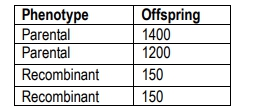Table of contents
- 1. Introduction to Genetics51m
- 2. Mendel's Laws of Inheritance3h 37m
- 3. Extensions to Mendelian Inheritance2h 41m
- 4. Genetic Mapping and Linkage2h 28m
- 5. Genetics of Bacteria and Viruses1h 21m
- 6. Chromosomal Variation1h 48m
- 7. DNA and Chromosome Structure56m
- 8. DNA Replication1h 10m
- 9. Mitosis and Meiosis1h 34m
- 10. Transcription1h 0m
- 11. Translation58m
- 12. Gene Regulation in Prokaryotes1h 19m
- 13. Gene Regulation in Eukaryotes44m
- 14. Genetic Control of Development44m
- 15. Genomes and Genomics1h 50m
- 16. Transposable Elements47m
- 17. Mutation, Repair, and Recombination1h 6m
- 18. Molecular Genetic Tools19m
- 19. Cancer Genetics29m
- 20. Quantitative Genetics1h 26m
- 21. Population Genetics50m
- 22. Evolutionary Genetics29m
4. Genetic Mapping and Linkage
Mapping Genes
Struggling with Genetics?
Join thousands of students who trust us to help them ace their exams!Watch the first videoMultiple Choice
Using the following data collected from a test cross, calculate the recombination frequency.

A
15.9%
B
10.3%
C
40.5%
D
32.7%
 Verified step by step guidance
Verified step by step guidance1
Identify the number of parental and recombinant offspring from the data provided. In this case, there are 1400 and 1200 parental offspring, and 150 and 150 recombinant offspring.
Calculate the total number of offspring by adding all the parental and recombinant offspring together: 1400 + 1200 + 150 + 150.
Determine the total number of recombinant offspring by adding the two recombinant categories: 150 + 150.
Calculate the recombination frequency using the formula: (Number of Recombinant Offspring / Total Number of Offspring) * 100.
Express the recombination frequency as a percentage to determine the genetic distance between the genes in question.
Related Videos
Related Practice
Open Question
Based on previous family studies, an autosomal recessive disease with alleles A and a is suspected to be linked to an RFLP marker. The RFLP marker has four alleles, R₁, R₂, R₃, and R₄. The accompanying pedigree shows a three-generation family in which the disease is present. The gel shows the RFLP alleles for each family member directly below the pedigree symbol for that person. After determining the genotypes for the RFLP and disease gene for each family member, answer the following questions.What is the most likely arrangement of syntenic alleles for the RFLP and the disease gene in I-1 and I-2?




